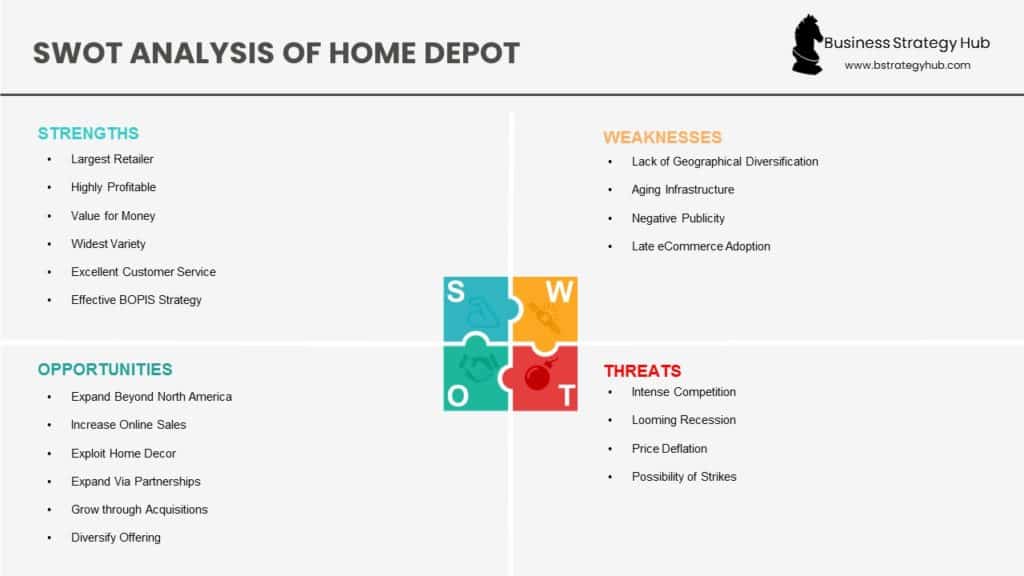Company: Home Depot Inc.
Founders: Bernie Marcus and Arthur Blank
Year founded: 1978
CEO: Craig Menear
Headquarters: Atlanta, Georgia, USA
Number of Employees (Dec 2019): 413,000
Ticker Symbol: HD
Public or Private Sector: Public
Annual Revenue (FY2019): $110.23 Billion
Profit | Net income (FY2019): US$11.24 Billion
Products & Services: Tools & Equipment | Building Materials & Hardware | Fixtures | Garden & Lawn | Lumber | Plumbing | Electrical | Paint | Millwork | Flooring | Kitchens | Furniture
Competitors: Amazon | Lowe’s | JC Penney | Menards | 84 Lumber | Ace Hardware | Target | Walmart | Best Buy | Staples | Kingfisher PLC.
Fun Fact: After opening the first Home Depot, Bernie Marcus and Arthur Blank filled up the store with empty boxes and paint cans because they did not have enough stock.
Home Depot has revolutionized the home improvement sector by cultivating a strong do-it-yourself marketplace.
For 40 years, it has risen gradually while destroying competitors along the way to become the second-largest retailer in America and the largest home improvement retailer, with sales topping $100 billion.
We can learn a lot by undertaking a Home Depot SWOT analysis.
Home Depot’s Strengths
- Largest Retailer: Size matters in business. As the largest home improvement retailer, Home Depot benefits more from the economy of scale than competitors. Also, it has the resources to fend off competitors and protect its market share. [Source 1]
- Highly Profitable: More profits allow for the accumulation of financial resources for core activities like R&D, marketing, and expansion. Home Depot’s net income margin increased by 8.4% in 2016, 8.6% in 2017, 10.3% in 2018, and 10.9% in 2019. [Source 2]
- Value for Money: Regardless of the product or service, customers always seek the one that offers the highest value for their hard-earned cash. Home Depot is obsessed with offering the best prices and introduced Match and Beat program. Customers match the prices with other retailers as they shop and Home Depot will beat lower competitors’ price by 10%. [Source 3]
- Widest Variety: In the home improvement retailing, Home Depot offers the widest variety. From tools to construction materials, fixtures, fasteners, furniture, and many more, customers can access all the unique home improvement products under one roof. [Source 4]
- Excellent Customer Service: It empowers employees’ creativity and the selflessness through recognition. In turn, Home Depot has nurtured a culture of excellence in customer service and always strives to enhance the shoppers’ experience. [Source 5]
- Effective BOPIS Strategy: Home Depot’s secret weapon is BOPIS (buy-online-pickup-in-store), which accounts for nearly 40% of online orders. The effectiveness of Home Depot’s BOPIS strategy has contributed to its profitability and growth. [Source 6]
- Increased Focus in eCommerce: Most retailers started adopting eCommerce as early as 2000 but Home Depot’s online sales stood at 1% in 2010 and around 6% in early 2019. In mid-2019, the company increased focus in eCommerce and digital transformation, which has grown tremendously. [Source 7]
- Great HR Policies: The key to success in retail is the retention of high performing employees. Home Depot is renowned for taking care of its employees and recently started paying college fees for employees to attain their dreams. [Source 8]
- Loyal Customer Base: From a value for money to excellent customer service, Home Depot’s customer-centric operations have nurtured a strong and loyal customer base. Most customers are extremely loyal to specific stores and visit the same store for years. [Source 9]
- Eco-friendly Options: Caring about the environment enables companies to not only fulfill corporate social responsibility but also market directly to the ever-increasing number of eco-conscious consumers. Home Depot’s ECO Program offers eco-friendly options like power-efficient tools for eco-conscious customers. [Source 10]
- Valuable Brand: Since its founding, Home Depot has focused on building a strong and valuable brand. It is ranked 32nd most valuable brand in the world. [Source 11]
Home Depot’s Weaknesses
- Lack of Geographical Diversification: Home Depot operates a total of 2,200 stores spread across North America, with about 180 in Canada, 125 in Mexico, and the rest in the US. Both the U.S. and Canada reaching maturity and the Mexican market is unstable. This makes Home Depot’s overdependence on North America a major weakness. [Source 12]
- Aging Infrastructure: One of the biggest challenges facing established retailers is aging systems and overall infrastructure. Home Depot invested over $10 billion for digital transformation only for the project to fail because of the aging infrastructure. [Source 13]
- Negative Publicity: In 2018, Home Depot fired an employee after he requested a disability-related emergency break. The company was forced $100K to settle the case, which tainted its reputation. [Source 14]
- Late eCommerce Adoption: While Home Depot’s online sales have increased immensely in the first half of 2020, it adopted eCommerce later than most of its competitors. It has wasted so much opportunity for growth by not adopting eCommerce early enough. [Source 15]
Home Depot’s Opportunities
- Expand Beyond North America: All its 2,200 stores are all in North America, which is flattening as it reaches maturity. Home Depot should be looking to expand beyond North America and into emerging markets like India, China, and others that offer immense opportunities for sustainable growth. [Source 16]
- Increase Online Sales: Home Depot’s online sales are around 6% of its overall business, which lower than 10% average. Its recent online push has given the company an edge over competitors like Lowe’s. This shows it has immense potential growth if it increases online sales. [Source 17]
- Exploit Home Décor: The potential for growth in the home décor sector is growing rapidly with key players like Bed, Bath & Beyond facing challenges. Home Depot acquired The Company Store and is now perfectly positioned to exploit the misfortunes of players in home décor. [Source 18]
- Expand via Partnerships: Home Depot expanded to China and opened seven stores but was forced to pull out after it failed to entice consumers. To expand more successfully, it can partner with local home improvement retailers in emerging markets who understand the marketplace. [Source 19]
- Grow through Acquisitions: It is quicker and much easier to grow through acquisition. Home Depot can acquire the struggling Bed, Bath & Beyond, and kill two birds with one stone: capture the home décor sector and catalyze growth. [Source 20]
- Diversify Offering: Instead of focusing solely on home improvement, Home Depot can diversify its offerings to include catering to the food retail sector or apparel. [Source 21]
Home Depot’s Threats
- Intense Competition: Lowe’s is closing the gap on Home Depot at an alarming rate. Also, Amazon poses a major threat to Home Depot’s market share. [Source 22]
- Looming Recession: Major construction and home improvements are scaled down or postponed in times of economic challenges. With the recession looming in the aftermath of the pandemic, Home Depot’s year-over-year increase in profits may come to an end. [Source 23]
- Price Deflation: The price of lumber has dropped significantly over the past 2 years, which has impacted Home Depot immensely since lumber accounts to 18% of its total revenue. The company failed to meet expectations after lumber prices dropped. [Source 24]
- Possibility of Strikes: The adoption of the USMCA has strengthened the bargaining power of employees. Already, Home Depot employees in Mexico want a 20% pay hike to reach their Northern colleagues. [Source 25]

References
- Trefis Team (2019, September 10). Lowe’s vs Home Depot: Home Improvement Or Stock Improvement? Forbes
- Great Speculations (2019, September 4). Here’s How Home Depot Stock Climbed 60% In 3 years. Forbes
- Basak, S. (2019, April 29). Home Depot’s Price Match Policy. Sift Wallet
- Trefis Team (2019, October 8). Comparable Sales To Push Home Depot’s Revenue Growth. Forbes
- Pearson, B. (2019, January 22). Home Depot Is Rehabbing The Shopper Experience. Can Other Retailers DIY The Same? Customer Think.
- Digital News (2020, February 27). Home Depot invests in B2B eCommerce, search, and online fulfillment. Digital Commerce 360.
- Danziger, P. N. (2020, February 26). Home Depot’s Transformation To A Fully Interconnected Retailer Shows Record-Breaking Results. Forbes
- Hess, A. (2020, February 12). Home Depot’s strategy for hiring 80,000 new workers: help them with paying for school. CNBC
- Loeb, W. (2018, December 21). Why Home Depot CEO Craig Menear Is The Retailer Of The Year. Forbes
- Merchant, E. (2018, November 6). Inside Home Depot’s Sustainability and Energy Strategy. Green Tech Media
- Forbes Ranking (2020). Company Profile: Home Depot. Forbes
- Solomon, D. B. (2020, January 15). Mexico union threatens the Home Depot strike, inspired by the USMCA trade deal. Reuters
- Giles, M. (2019, November 20). Home Depot’s $11 Billion Digital Rebuild Hits A Legacy-Tech Speed Bump. Forbes
- Law Review (2018, August 17). Home Depot to Pay $100,000 To Settle EEOC Disability Discrimination Lawsuit. The National Law Review
- Kumar, S. U. (2019, November 19). Home Depot cuts sales goal as online push not delivering as expected. Reuters
- Shoulberg, W. (2019, July 17). The 5 Things Home Depot Needs To Do As It Marks 40 Years In Business. Forbes
- Digital Perspectives (2019, August 23). Home Depot grows online sales five times faster than Lowe’s in Q2. Digital 360
- Kapner, S. (2019, June 2). Amazon Didn’t Cripple Bed Bath & Beyond. Its Own Leaders Did. The Wall Street Journal
- Karin, S. (2019, June 14). Why Home Depot failed in China. CNBC
- Meyersohn, N. (2020, March 22). Bed Bath & Beyond will close all brand stores until April 3. CNN Business
- Cook, L. (2019, August 9). They serve food at the midtown Home Depot now. You will want to read the menu carefully. The Pitch
- Danziger, P. N. (2020, May 20). Lowe’s Is Narrowing The Gap Between Its Chief Rival Home Depot. Expect Its Surge To Continue. Forbes
- Kumar, U. (2020, May 19). Home Depot misses profit estimates as coronavirus costs weigh. Reuters
- Garcia, T. (2019, August 21). Home Depot will feel the impact of lumber price deflation and Lowe’s improvement. Market Watch
- Milenio, S. P. (2020, January 16). Home Depot workers seek a 20% pay hike, threaten to strike in 13 states. Mexico News Daily
Tell us what you think? Did you find this article interesting?
Share your thoughts and experiences in the comments section below.












Add comment